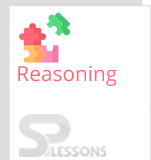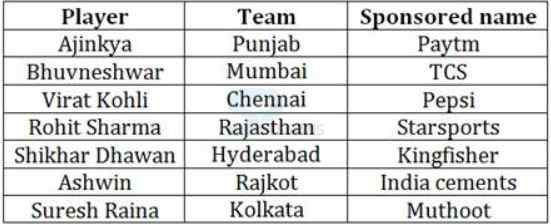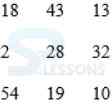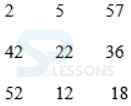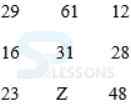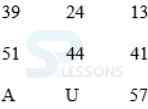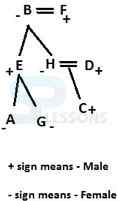 Introduction
Introduction
IBPS Clerk 2019 – Preliminary Examination, conducted in online Mode, has: a duration of 1 hour, a total of 100 questions, a maximum score of 100 marks, and, consists of 3 sections, namely – English Language, Numerical Ability and Reasoning Ability. The 3 sections are separately timed and the questions can be attempted in any order. IBPS Clerk 2019 Prelims exam is scheduled on 07.12.2019, 08.12.2019, 14.12.2019 & 15.12.2019 and Mains Exam is scheduled on 19.01.2020.
 Pattern
Pattern
| S.No | Name Of Test | No.of Questions | Maximum Marks | Duration |
|---|---|---|---|---|
| 1 | English | 30 | 30 | 20 minutes |
| 2 | Numerical Ability | 35 | 35 | 20 minutes |
| 3 | Reasoning Ability | 35 | 35 | 20 minutes |
| Total | 100 | 100 | 60 minutes |
 Syllabus
Syllabus
| Topic | Number of Questions |
|---|---|
| Inequalities | 0-5 |
| Syllogism | 0-5 |
| Coding | 0-5 |
| Puzzles | 5-10 |
| Seating Arrangement | 0-5 |
| Blood Relaitons | 0-1 |
| Ranking | 1-2 |
| Direction Sense | 1-2 |
Note: Penalty for Wrong Answers
There will be penalty for wrong answers marked in the Objective Tests. For each question for which a wrong answer has been given by the candidate one fourth or 0.25 of the marks assigned to that question will be deducted as penalty to arrive at corrected score. If a question is left blank, i.e. no answer is marked by the candidate, there will be no penalty for that question.
 Quiz
Quiz
Direction(1-5): Read the following information carefully and answer the questions.
There are seven Players — Ajinkya, Bhuvneshwar, Virat Kohli, Rohit Sharma, Shikhar Dhawan, Ashwin and Suresh Raina. All of them are playing in a tournament in different Teams — Chennai, Mumbai, Rajasthan, Rajkot, Kolkata, Punjab and Hyderabad but not necessarily in the same order. Moreover, their teams are also sponsored by different service providers— Muthoot, India cements, Kingfisher, TCS, Paytm, Pepsi and Starsports.
Further, some more information is also given:
- A. Rohit Sharma, a Rajasthan player, does not sponsored by Muthoot. The one who is of the Punjab is sponsored by Paytm.
B. Ajinkya does not sponsored by India cements while Bhuvneshwar, who is a Mumbai player, is sponsored by TCS. Shikhar Dhawan and Ashwin do not associate with Punjab.
C. Shikhar Dhawan, a Kingfisher player, has Hyderabad team, while the person who is in Rajkot is sponsored by India cements.
D. Virat Kohli is a Pepsi sponsored player, while Suresh Raina, who is not in Chennai, is a Muthoot sponsored player.
- A. Suresh Raina
B. Ashwin
C. Virat Kohli
D. Shikhar Dhawan
E. None of these
- A. Starsports
B. Muthoot
C. Kingfisher
D. Paytm
E. None of these
- A. Ashwin is in Hyderabad Team.
B. Ajinkya is Starsports Sponsored
C. Rohit Sharma is Kingfisher Sponsored
D. All are true
E. None of these
- A. Ajinkya
B. Suresh Raina
C. Shikhar Dhawan
D. Ashwin
E. Virat Kohli
- A. Bhuvneshwar- Chennai- TCS
B. Ashwin- Rajkot- Pepsi
C. Virat Kohli- Chennai-Muthoot
D. Shikhar Dhawan- Kolkata-Muthoot
E. Ashwin- Rajkot- India cements
Direction[1-5]: In the question three columns are given and to find out the resultant of a particular column you need to follow the following steps:
Step 1: If an even number is followed by another even number, then the resultant will be the number which is obtained after the addition of both numbers and ‘4’ is subtracted from the total sum.
Step 2: If an odd number is followed by an even number, then the resultant will be obtained by dividing the smaller number by ‘2’ and subtract from the larger number.
Step 3: If an even number is followed by an odd number, then the resultant will be the multiplication of both the numbers.
Step 4: If an odd number is followed by another odd number, then the resultant will be the number which is next multiple of the obtained number after subtracting the smaller from the larger number.
Step 5: If a number which is the result of the addition of two consecutive perfect squares is followed by either odd/even numbers (may or may not be a perfect square number), then the resultant will be the next prime number after the addition of both the numbers.
1. Find the resultant of column 1, if U is half the sum of resultant of both the column 2 and column 3?
- A. 88
B. 86
C. 96
D. 82
E. 56
- A. 33:10:21
B. 36:16:21
C. 33:14:19
D. 10:33:22
E. 45:17:11
- A. 133
B. 145
C. 141
D. 157
E. 188
- A. 103
B. 153
C. 133
D. 113
E. 136
- A. 4, 68
B. 6, 68
C. 64, 88
D. 64, 86
E. 8, 8
1. Nandini is the only daughter of Madan’s sister Sangita’s brother. How is Nandini related to Madan?
- A. Daughter
B. Niece
C. Cousin
D. Niece/Daughter
E. None of the above
- A. Son
B. Daughter
C. Son or Daughter
D. Data inadequate
E. None of these
- A. Grand Son
B. Grand Daughter
C. Son
D. Daughter
E. None of these
- A. Brother
B. Sister
C. Cousin
D. Cousin Sister
E. Can’t be determined
- A. F, B, G, H
B. B, A, H, G
C. H, C, B, A
D. D, E, G, A
E. None of these
